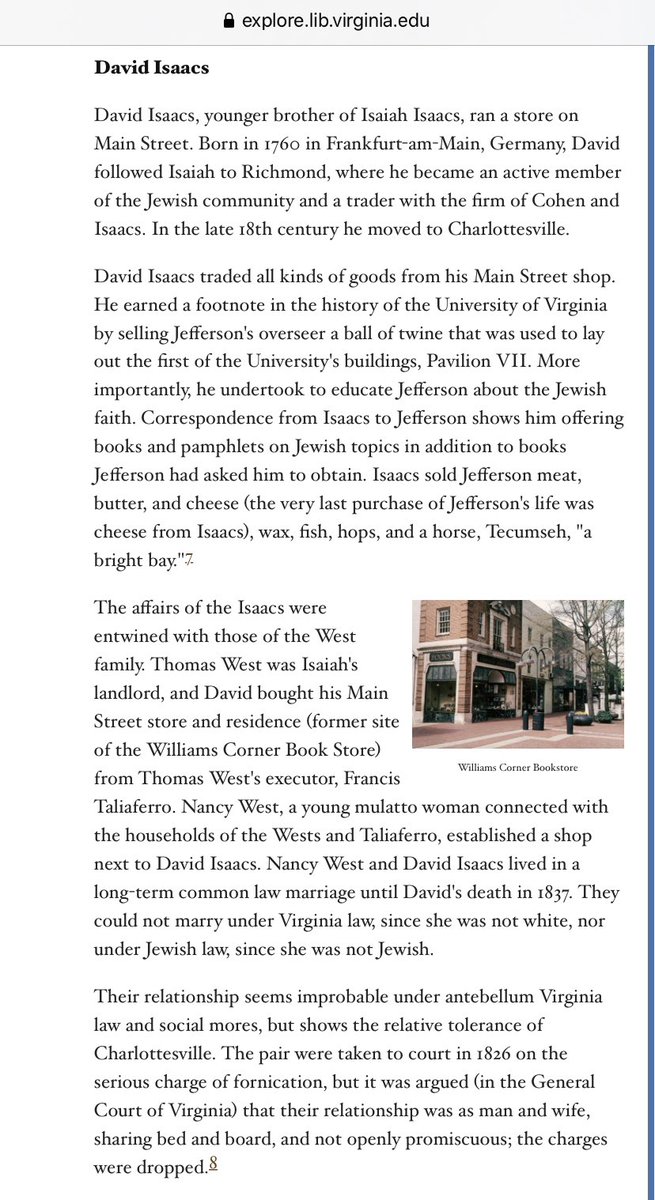this morning’s court square markers subcommittee of the historic resources committee has a guest to talk to them about the jewish history of downtown charlottesville
david isaacs was a jewish resident of charlottesville in the late 18th century who had a relationship with nancy west, a black woman.
https://explore.lib.virginia.edu/exhibits/show/seek/early">https://explore.lib.virginia.edu/exhibits/...
https://explore.lib.virginia.edu/exhibits/show/seek/early">https://explore.lib.virginia.edu/exhibits/...
the synagogue, which is a short walk from court square (originally it was actually right here where the library is now - it was moved in 1904 when the federal government demanded this land for a post office) was founded in 1882.
the third notable site of jewish history downtown is the levy opera house. that building originally functioned as a town hall before it was purchased by jefferson monroe levy and converted to an opera house
https://www.charlottesville.org/departments-and-services/departments-h-z/neighborhood-development-services/historic-preservation-and-design-review/historic-resources-committee/local-markers/opera-house">https://www.charlottesville.org/departmen...
https://www.charlottesville.org/departments-and-services/departments-h-z/neighborhood-development-services/historic-preservation-and-design-review/historic-resources-committee/local-markers/opera-house">https://www.charlottesville.org/departmen...
jalane ties together this story with the narratives we’ve discussed in previous meetings with the removal of m’kee row, the black neighborhood on the opposite side of the park. that neighborhood was an eyesore for well to do white folks going to the opera house.
alyssa pulls up the current text for the marker at the levy opera house - it has some weirdly granular information about it specific performers that came to the opera house. she says maybe we could use that marker to tell a more connected story about jewish history.
phyllis says the relationship between david isaacs and nancy west was largely unproblematic for many years even as they had children together... until they actually moved in together. they were charged with illicit sex but never found guilty.
there was no sizeable jewish population in charlottesville until the 1850s or 60s, she says.
jordy asks phyllis what jewish stories should be told in these markers.
jordy asks phyllis what jewish stories should be told in these markers.
that first wave of jewish immigration into the area was generally wealthier, highly educated and many became merchants. in the 1880s and 90s, jews fleeing pogroms in europe began to arrive here - phyllis says this is the point at which there is a larger nativist reaction.
“the 20th century story is a story of merchants finding their way here but it’s also a story of greater vulnerability as the klan formed, and it’s also a time when those 19th c. jewish families leave charlottesville.”
the jewish community here dwindled to about 12 families.
the jewish community here dwindled to about 12 families.
the synagogue had no professional clerical leadership until 1979, she says. occasionally there was a visiting rabbi, but it was largely a lay-led congregation.
jordy brings up the fact that local racial covenants specifically excluded jews from owning property in many areas.
alyssa asks if the klan revival occurring at monticello has anything to do with monticello being owned by jefferson levy, a jewish man.
“i don’t know if it’s necessarily because of the intolerance, it’s just the [lack of] opportunities,” she says of jewish flight from charlottesville in the early 20th century.
jordy asks for any notable jewish firsts. she says our first jewish mayor was sol weinberg in the 1950s. she notes though that while he had jewish heritage, he was not active in the synagogue and was married to an episcopalian woman.
genevieve keller says the opening of farmington country club in 1930 was a clear social demarcation - it did not allow jewish members.
(what a cool free history lesson this is! i did not expect this of my morning meeting!)
jordy asks phyllis about efforts the university is making to put up historical markers about local jewish history.
she says one initiative UVA is currently undertaking is looking at building names... whether some buildings might need new names (they do!)
she says one initiative UVA is currently undertaking is looking at building names... whether some buildings might need new names (they do!)
the poet karl shapiro attended UVA in the 1930s. “to hurt the negro and to avoid the jew is the curriculum,” he wrote in a poem about his time at UVA. he didn’t stay at the university.
alyssa brings the conversation back to the court square markers - what stories can be told in that space?
“i’ve been thinking about insiders and outsiders - who is an outsider in a community?” phyllis asks. she says jews have been both in the history of this community as culture shifts. in the late 19th c. jewish merchants were civically & culturally prominent.
when moses kaufman, who had been the chairman of the school board, died (around 1880, i think?), schools closed so teachers could attend his funeral, she says.
“i think it’s lovely that you’re interested in learning more about the jewish story, but i do think it’s a complex story,” she says

 Read on Twitter
Read on Twitter



